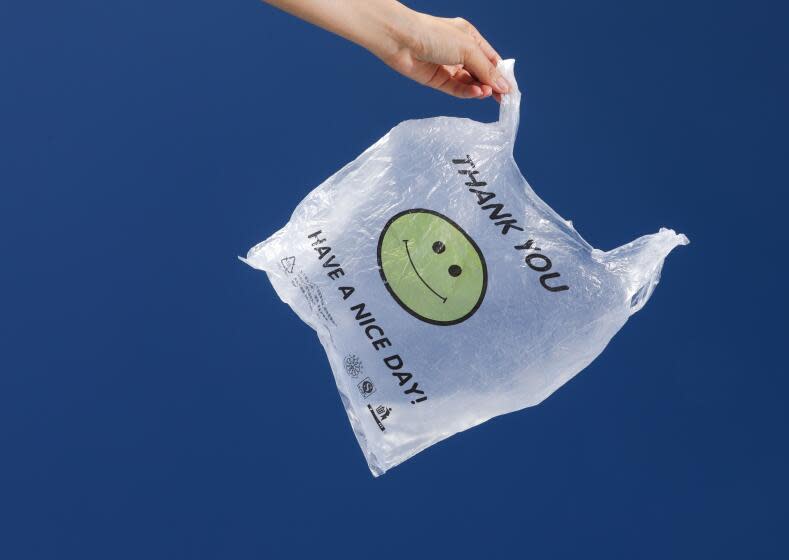How many people are taking reusable bags to the grocery store? Not many. We counted

I always take my reusable bags to the grocery store. I don't like spending 10 cents or 25 cents for something I already have. My reusable bags are usually more comfortable to carry since I can sling the longer straps over my shoulder. And I hate thinking about generating plastic waste when I don't need to.
It's an ingrained habit, like remembering to bring my phone and purse.
But as I started reporting on California's plastic bag ban, I wondered how many people did the same.
Data were hard to come by. CalRecycle, the government agency that oversees California's waste management and recycling programs, sent a voluntary survey to stores six months after the ban went into effect in 2016. The self-reported data painted a cheerful picture of the law’s impact: In 86% of transactions, customers did not purchase a bag. In 11% of transactions, a customer purchased one of the new thicker plastic reusable bags; 3% purchased a recycled paper bag.
The survey looked at the number of plastic and paper bags given out before and after the ban. Over a six-month period before the ban went into effect, 1,500 stores gave out 435 million low-density polyethylene, or LDPE, bags and 116 million paper bags. After the ban went into effect, in a six-month period, those stores sold 66 million high-density polyethylene, or HDPE, bags and 45 million recycled paper bags.
I don't doubt there was a flurry of compliance in the immediate wake of the law, especially since every grocery store had signs reminding us to bring our bags, plentiful reusables — the plastic ones and also variations in cloth and woven plastic — for sale, and cashiers asking us loud and clear if we brought a bag or would like to pay for new ones. But times have changed. There was a pandemic, and I'm sure lots of people fell out of the habit of bringing their own bags. The signs have disappeared. The only bags at the register are the HDPE ones. And it's been a long time since I've heard a cashier point out, to me or any other shopper, that they cost extra.
Every time I've been in a checkout line lately, I look at the customers around me. Usually, I'm the only one hauling my own crumpled bags around.
CalRecycle has never repeated its 2016-17 survey. So in the absence of state data, another reporter and I stood outside of some grocery stores to see what we could observe.
I learned that a lot of people leave grocery stores without a bag.
In the CalRecycle survey, these shoppers were lumped together with people who brought reusables as evidence of the ban’s success. But from what I observed, almost all of them left with a single item it wouldn’t make sense to bag: a 12-pack of soda, a bag of chips, a disposable cup from an in-store Starbucks (not exactly an environmental "win."). At each store I observed, only one or two shoppers left with a cart that had enough loose unbagged items to suggest they could have justified buying a new bag but decided not to.
Only counting customers who left with a bag of some type, at every store, many more customers left with new bags than with reusables — usually more than twice as many. I counted 337 customers coming out of a Target in Culver City: 146 had all new plastic bags; only 25 had brought reusable bags. Only four of those shoppers were reusing plastic bags. Most reusables were made of sturdier materials, such as cotton or woven polyethylene.
Read more: California's plastic bag ban is failing. Here's why
Of 177 customers at a Ralph’s in Culver City, 70 had all-new plastic bags while 43 had brought reusable bags with them. Four of those people had brought back plastic bags.
I also observed shoppers at a Whole Foods in Playa Vista and Trader Joe's in Culver City. Both of these stores cater to a more upscale, eco-conscious clientele, so I thought more of their customers might bring bags. And neither of these stores will sell you a plastic bag; they offer paper bags for 10 cents.
At Whole Foods, 79 shoppers emerged with all-new paper bags, while 29 had reusables. I watched one woman exit the store with two paper bags, set them down on a table, then condense her groceries into one bag. She folded and discarded the other paper bag into a recycling bin approximately 20 feet from where she'd purchased it.
At Trader Joe's, 52 shoppers left with all-new paper bags, and 27 left with bags they brought from home.
At a Smart and Final and a Grocery Outlet in Fresno, 34 shoppers emerged with new plastic bags. A grand total of one person had a single, small, reusable bag.
Read more: A reporter kept a diary of her plastic use. It was soul-crushing
This story originally appeared in Los Angeles Times.


